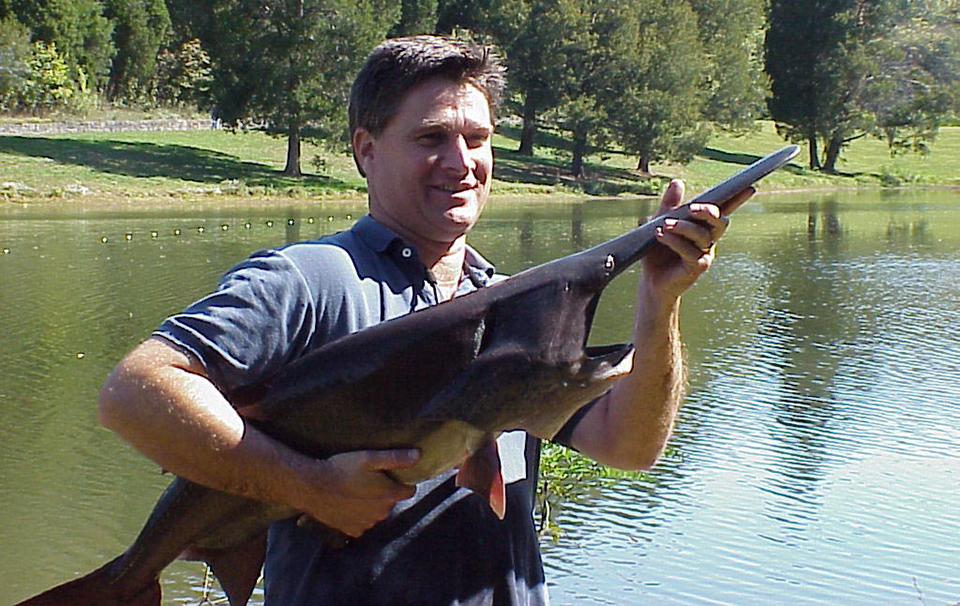Sturgeon relative protected by federal, international bodies

Paddlefish are endemic to most large rivers and tributaries of the Mississippi River basin of the United States. Found in 22 U.S. states, they are related to sturgeons and highly valued for their grayish-black roe, which is processed into caviar, and boneless, firm, white meat.
Many federal and state hatcheries in the U.S. produce paddlefish for stock rehabilitation programs. Private culture of paddlefish is in a research/developmental phase, to provide an alternative source for its caviar and recreational fishing.
Need for aquaculture
Aquaculture of paddlefish is becoming necessary because of stock depletion and/or the closure of fisheries, and strict federal and state regulations. It will provide an alternative source for the marketplace.
In 1989, the U.S. Fish and Wildlife Service listed paddlefish as a “category 2” species because data were lacking on its population status. In 1992, they were added to the Appendix II list of the Convention for International Trade in Endangered Species (CITES), primarily due to concern about illegal poaching for the international caviar trade. Ten states are currently growing and stocking paddlefish to supplement existing populations.
Seedstock production
Broodstock are mostly obtained from wild sources, though domesticated broodstock are available in limited numbers. Larval paddlefish can be trained to accept artificial diets in intensive tank culture until about 10 cm in length, when they are stocked at 800-1,600 fish per hectare in ponds. They are fed a floating trout/salmon diet until the fish are at least 25 cm in total length.
Sex manipulation
Mass production of all-female paddlefish has been developed using sex manipulation techniques. Further, a system to produce all-female offspring by breeding sex-inverted, genetic females known as neo-males is now being tested.
If this system is verified to produce all-female offspring, frozen milt from neo-males will permit farmers to produce all-female paddlefish for caviar production. The female fish will mature and produce eggs for caviar at 7 to 9 years in the southern region of the United States.
Production systems
Reservoir ranching and pond polyculture with catfish are two practical systems for raising paddlefish for caviar and/or meat. Both systems rely on the presence of natural food production or zooplankton, since paddlefish are filter feeders that require zooplankton as their primary food source.
Ranching
Reservoir ranching, most suited for caviar production, is an extensive aquaculture production system in which young fish (over 30 cm) are stocked at 2 to 4 fish per hectare into a reservoir, permitted to forage on zooplankton, and harvested when sexually mature. Production can reach 90 kilograms per hectare in reservoirs, depending on water productivity, food supply, and water temperature. Reservoir ranching has been shown to be sustainable and nonpolluting.
Pond production
Pond culture of paddlefish with catfish is a more intensive system than reservoir ranching, and is the better system for meat production. Production yields can reach about 180 kilograms per hectare. Fish have shown average growth rates of over 230 grams per month in the southeastern U.S.
Marketing and value-adding
Value-added meat products such as hot- and cold-smoked products are the major items being developed for the marketplace. The consumer acceptability of such value-added products has been demonstrated. In fact, caviar processed from reservoir-ranched female paddlefish has been judged superior to caviar processed from wild-caught paddlefish.
Conclusion
It is important for federal and state agencies and the aquaculture industry to work together to best develop farm-raised paddlefish in the United States and create a reliable supply of caviar and meat for commerce. Legislation and regulations should be considered to permit reservoir ranching of paddlefish.
Research and development are needed for the development of a larval diet for paddlefish and treatments for bacterial infections of fish reared in tank systems. Also, research is needed in molecular biology for stock identification and milt cryobiology.
(Editor’s Note: This article was originally published in the February 2002 print edition of the Global Aquaculture Advocate.)
Now that you've finished reading the article ...
… we hope you’ll consider supporting our mission to document the evolution of the global aquaculture industry and share our vast network of contributors’ expansive knowledge every week.
By becoming a Global Seafood Alliance member, you’re ensuring that all of the pre-competitive work we do through member benefits, resources and events can continue. Individual membership costs just $50 a year. GSA individual and corporate members receive complimentary access to a series of GOAL virtual events beginning in April. Join now.
Not a GSA member? Join us.
Author
-
Steven D. Mims, Ph.D.
Aquaculture Research Center
Kentucky State University
Frankfort, KY 40601, USA
Tagged With
Related Posts

Intelligence
Paddlefish culture expanding beyond U.S., Russia, China
Although U.S. hatcheries aid stocking programs, paddlefish culture has not been commercialized. Russia and China raise the fish for meat and caviar.

Intelligence
China’s limited paddlefish culture focused on meat production
Fish farmers rear paddlefish as a substitute for bighead carp in more than 10 provinces in China. Limited supply and high fingerling prices limit expansion of production.

Health & Welfare
Wastewater reuse supports paddlefish project
A pilot project in Kentucky that uses wastewater effluent and decommissioned tanks at a water treatment plant has cultured over 70,000 phase II paddlefish.

Health & Welfare
Freshwater fish culture in China
About 60 percent of China’s aquaculture production is freshwater fish. Carps top the list, although many other native and non-native species are also raised.


